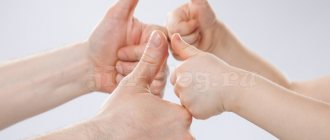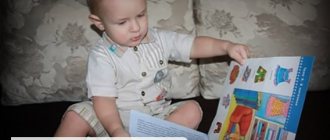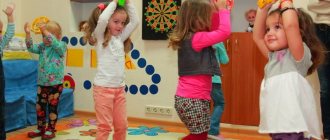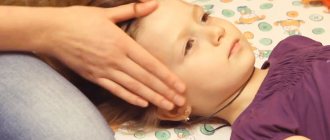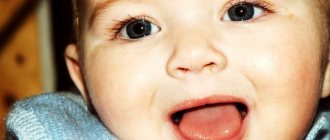Speech characteristics of children 4-5 years old
At this age, children begin to actively expand their vocabulary. So, by the age of 5, on average, a child already has about three thousand words in stock. In addition, five-year students begin to create more complex sentence structures. If previously they consisted of a maximum of 3-4 words, then at this age one sentence can consist of up to 10 words.
Speech therapy classes for children 4-5 years old are very important
Sentences produced by a child aged 4-5 years are not always logically constructed correctly. If a child is telling a long story or retelling a fairy tale, he does not need to be corrected if the main idea or logic is lost. For this age this is within the normal range.
Note! Also, at the age of five, children often not only tell what they saw or heard, but also make up stories themselves, without relying on their life experience. This only once again confirms the correctness of development. Ridiculous stories are one of its components.
Basic characteristics of a child’s speech at 4-5 years old
By the age of five, a child already begins to distinguish sounds and is able to determine the presence or absence of a particular sound in a certain word. Normally, during the period of 4-5 years, a child should already have completed the formation of the pronunciation of certain sounds and letters that were previously difficult to achieve. So, for example, at 4 years old all hissing sounds should already be present in speech. And by the age of 5, a child should master such complex sounds as “l” and “r”.
In practice, everything is not always so perfect and more than half of children have some speech deviations. The following speech underdevelopment occurs:
- phonetic;
- phonetic-phonemic;
- general.
Important! Simply put, children do not recognize, discriminate, or have serious difficulty pronouncing sounds.
When you need help
Experts assure that you can understand what problems may arise in speech almost from birth:
- if by the end of 1 month the baby does not try to let him know by screaming that it is time for him to eat, or when he experiences discomfort;
- if at the end of 4 months he does not respond with a smile;
- if by the end of the fifth month he does not make individual sounds, pointing with his gaze at the object he means. For example, mom asks: “Where is the rattle?”;
- by the end of the 7th month does not try to attract attention with the help of spoken sounds;
- at the end of the 9th month, words consisting of repeated syllables, such as “ma-ma”, “pa-pa”, did not appear in the baby’s vocabulary;
- at 12 months does not respond to simple requests: “Give me a toy.”
Types of speech defects
Before you start classes, you need to know the types of speech disorders:
- stuttering;
- dyslalia;
- nasality;
- neurological diseases.
For your information! To identify them, you just need to regularly communicate with your child.
Basic characteristics of speech at 5-6 years old
By this time, speech develops and becomes more complex. The baby is already able to make hissing and whistling sounds. The expressiveness of speech increases, you can notice this when reading poetry and in role-playing games. It becomes coherent and sentences become more common. Children are already able to retell a fairy tale or describe a picture.
How to conduct classes at home correctly
It is not necessary to immediately run to a speech therapist. To begin with, you can try exercises for speech therapy classes for children 4-5 years old at home. They will help the child master correct speech, learn to hear and pronounce missing sounds.
Children should definitely be taught at home so that they learn how to pronounce sounds correctly.
Typically, speech therapists advise following these simple rules:
- Exercises should be performed every day, always in a child-friendly environment.
- Be sure to conduct lessons in a playful way. It is important to captivate the child so that the tasks do not seem boring and uninteresting to him. You can even arrange a sort of competition to see who can complete the tasks better or faster.
- You cannot criticize or make sarcastic remarks to your child. So the desire to learn something new will disappear completely. Be sure to praise your child when he completes a task. Even if something doesn’t work out, you need to praise him for trying.
- For classes, be sure to use literature that is designed to help parents teach their children independently. There are special reference books on speech therapy, which contain many different exercises for children, as well as recommendations for parents.
- A speech therapy exercise for children 4-5 years old can be turned into pleasure if you correct your speech by studying rhymes and tongue twisters. They will not only allow the child to quickly grasp the necessary sounds, but will also have a positive effect on the development of memory.
- You need to show your child an example of correct speech. Pronounce all words clearly so that the baby understands and clearly hears what is being said to him. You need to talk to him as much as possible, have conversations on any topic, tell different stories.
Complex of articulation gymnastics for children 4-5 years old in the middle group
High-quality warm-up for lips and tongue
Warming up the lips and tongue plays an important role in the formation of correct speech.
Note! The baby will begin to pronounce words more clearly, without swallowing the ending.
Exercises as a warm-up:
- Stretch your lips in a smile without showing your teeth. You should try to smile as widely as possible.
- Pull your lips forward as if they were an elephant’s proboscis.
- Take turns inflating one or the other cheek, then retract them in the same order.
- Open your mouth and pull your lower jaw as low as possible, while holding your tongue to the roof of your mouth.
- Open your mouth, stick out your tongue. Then put it in your mouth. Do this exercise for 15 seconds.
- Pull out your tongue and blow on a piece of cotton wool on the table until it falls off the table. Blowing with lips is prohibited.
- Use the tip of your tongue to first move along the upper teeth from the inside, then along the lower ones.
- “Scratch” your tongue with your teeth, resting on the lower gum.
Important! To achieve visible results, you need to perform these exercises regularly. Each of them must be repeated at least 5-6 times.
When is it necessary to contact a speech therapist?
Each child is individual. Some people begin to speak early, but use two-word constructions for a long time; others begin to speak by the age of three, but in whole sentences and without any special problems with sound pronunciation. It all depends on the pace of the child’s overall development, his environment, past illnesses, etc.
But there are still certain signs that parents should not ignore.
Here are some of them:
- the child shows no interest in toys, all his games are stereotypical and monotonous;
- a child after two years of age cannot cope with simple tasks, such as putting a large bead on a rope or assembling a tower of cubes;
- does not understand simple instructions, such as fetching a ball;
- if the child does not speak, and there is a history of hereditary diseases, illnesses during pregnancy, or birth injuries.
Exercises for general speech development at home
At home, it is imperative to regularly conduct speech therapy classes for children 4-5 years old, the exercises of which include not only the speech part, but also gymnastics for the speech organs and fingers.
Finger gymnastics
This set of simple exercises stimulates the part in the brain center that is responsible for correct speech. This is why fine motor skills classes are needed not only for the little ones, but also for preschoolers.
Finger exercises stimulate the part of the brain responsible for correct speech
All exercises are done 8-10 repetitions:
- “Opening” and “closing” the fingers on each hand. First one by one, then together. You can gradually increase the speed.
- Place your hands on the table: the left one touches the table with the palm, the right one with the back. Then at the same time you need to turn your hands over.
- First, draw a river: fold your hands, palms up, as if you have water in them. Then depict a steamboat - put your palms together, press your thumbs together and lift them up. Then depict the fish that have arrived: press all your fingers together, palms together and make movements with your hands, as if a fish is swimming.
- Draw a tree with branches - arms vertically, fingers spread out in different directions. Then show the roots of the tree - in the same position, move your hands with your fingers down. Then show leaf fall: quickly, quickly clench and unclench your fingers.
Articulation gymnastics
These exercises are aimed at developing the tongue, the main organ responsible for the correct pronunciation of sounds.
Complex of articulatory gymnastics for children 2-3 years old
Note! Thanks to regular training in articulation gymnastics, the child will soon begin to pronounce even the most difficult sounds.
- Smile as wide as possible, teeth are closed, exactly on top of each other. Stay in this position and count 10 seconds.
- Pull your lips forward and pretend as if an elephant is drawing water with its trunk. Stay for 10 seconds in this position.
- Pretend to be a snake: smile broadly, stick out your tongue like a tube, then hide it back.
- Open your mouth wide and make a clicking sound with your tongue, imitating a horse. At the same time, it is important to ensure that the child’s lower jaw is motionless and only the tongue is working.
- Smile widely, stick out your tongue as far as possible and lightly squeeze it between your teeth. In this position, “pull” the tongue back into the mouth.
- Open your mouth wide, stick out your tongue and pretend to be a clock - move your tongue from one corner of your mouth to the other.
Repeat all these exercises 8-10 times or for 10-15 seconds.
Games for developing phonemic sound
Speech therapy games for 4-5 year old children to develop phonemic sound must be included in daily classes. They are simple and at the same time interesting, and the results will not take long to arrive. After just a month of regular exercises, the quality of children's speech will noticeably improve.
- "Game of Silence" This game is very simple. The child is asked not to make a sound for 2 minutes and close his eyes. As soon as the time is up, then ask the baby to tell what sounds he heard.
- "Clap-stomp." The essence of the game: agree in advance with the child which sound he will stomp on and which sound he will clap on. For example, if he hears the sound [w], then he stomps his foot, if the sound [r], then he claps his palms. Next, the adult names different sounds, and when the child hears the ones he needs, he claps or stomps.
- "Catch the word." The essence of this game is simple: the child is given a word, upon hearing which he will have to clap his hands. Next, the adult names several words in turn that sound similar. As soon as the child hears what he needs, he should clap his hands.
To develop phonemic sound, it is necessary to regularly play speech therapy games
Activities for clear speech
Five-year-old children are already very smart and are excellent at repeating after adults and reproducing even very complex actions. Indeed, articulation tasks can sometimes be quite difficult. We have excluded all the most difficult ones and left only those exercises that are easy to perform and at the same time very effective. They will be an excellent workout for children with special needs.
Articulation gymnastics
- Smile widely, showing everyone your teeth. Then we pull the sponges forward with a tube.
- Tighten your lip muscles as much as possible, then smoothly relax.
- Lightly bite the lower and upper lips alternately.
- We use our tongue to depict the clatter of hooves. All kids love to do this.
Warm-up time will take no more than 15 minutes. All exercises will be useful not only for children, but also for adults who have some problems with diction.
We will also offer fun and effective speech games for children 5-6 years old for correct sound pronunciation:
- Play the baby's cry: "Wa-wa!"
- We squeal like mice: “Peep-pee-pee.”
- We scream as if we were lost in the forest: “Ay! Aw!”
- We hum like the wind in the mountains: “Uuuuu!”
- We combine vowels and consonants. We scream like animals: “Meow”, “Woof”, “Kwa-kwa”, “Ga-ha-ga”.
- We growl like bears: “Rrrrr!”
- We sing a song: “La-la-la, la-la-la.”
By the way, singing is very useful for learning correct speech. Any favorite song will come in handy. Many children really love songs like “There was a birch tree in the field” or “Two cheerful geese lived with grandma.” They will be excellent helpers, because there is a smooth stretching of sounds, and this is a great thing for correcting pronunciation. It is not for nothing that in kindergartens the educational program necessarily includes music classes, although they do not exclude the activities of a speech therapist, who is also present there.
Kindergarten classes
In kindergartens, as a rule, speech therapy games are held, which are divided into 2 main types:
- Individual. When a certain child has a problem that needs to be solved.
- Group. Classes are held simultaneously with several children who have similar speech defects.
READ ALSO: When do children begin to talk with proper development?
Such classes are necessary in every preschool institution, but the truth is that they are not available everywhere. Closer to school age, speech therapy classes become mandatory, because preparation for school is underway. Chanting will be a great workout. They seem to be songs, but not simple ones. Sound pronunciation occurs along with the performance of certain actions.
Good game "Flying Plane". The kids imitate the sound of a flying airplane in unison: “Uuuuuu!” At the same time, to be convincing, you should spread your wings. We command:
- The plane flies closer (the hum becomes louder), the plane flies away (the sound becomes quieter).
- Breaking! Simultaneously with the humming, babies hit themselves on the chest with their palms.
- We're about to land! Continuing to hum: “Uuuuu!” airplanes land and sit on their seats.
Practice with a microphone. Try showing your children how the volume of sound changes when we move the microphone closer or further away.
Remember that most problems can be solved. The main thing is not to neglect or leave everything to chance, but to engage and develop, then even diagnoses like mental retardation or mental retardation will not seem so scary.
Features of practicing hissing sounds
To teach a child to correctly pronounce hissing sounds, you must first introduce whistling sounds. If a child in the fourth year of life has learned to pronounce whistling sounds, then there should be no problems with hissing sounds. You can install them with a few simple exercises.
- "Naughty tongue." The child sticks the tip of his tongue out of his mouth. Then he lightly slaps it with his fingers, while saying: “five-five-five.”
- "Delicious jam." The lower lip is pulled down so that the teeth are visible. And the tip of the tongue licks the upper lip, as if it is very sweet there. At the same time, the lower jaw should remain motionless during the exercise.
- “Hide the candy.” Mouth closed. Tighten your tongue and touch your left, then your right cheek. It's like there's candy hiding behind your cheek.
Repeat exercises at least 5 times.
Note! Producing the sounds of native speech is very important for children. It will help them not only make contact with their peers, but also better master the preschool and school curriculum. Parents have the power to help their children avoid difficulties in the future and put the sounds correctly in time.
Speech didactic games as a type of activity
Play is a basic personal need in the preschool period of a child’s development, therefore it is necessary to organize the educational process in such a way as to use the interest and desires of preschoolers for pedagogical purposes. Properly organized game activities, visual and didactic material, and a comfortable psychological atmosphere ensure not only the transfer of necessary knowledge, mastery of age-appropriate skills, but also the formation of a certain level of culture.
Both parents and teachers can use didactic games to help their child with speech development. When a diagnosis has been made, you can select didactic games on the relevant problem and focus on those that are effective, interesting, exciting, enrich your inner world, and broaden your horizons.
Types of didactic games that develop speech
Didactic games of the first and second types develop tactility and motor skills, promote the activation of attention and thinking, the actualization of existing knowledge and skills, the development of visual memory, and creative imagination.
Verbal didactic games are used in pedagogical activities in organizing the educational and correctional process to solve problems with speech development in children. Words and actions are the main tools for play activities with preschoolers
Verbal didactic games develop dialogical speech skills and activate attention. Such games serve as a means of developing memory, attention, coherent dialogical speech, and form a vocabulary for expressing one’s desires and thoughts.
They practice correct sound pronunciation, clarifying and consolidating articulation, and contribute to the activation of vocabulary.
Rules for organizing and conducting didactic games for speech development
In order for the results of didactic games and all correctional work to be positive, it is necessary to follow a number of instructions.
Before choosing a game, you should study the child’s interests, take them into account, encourage communication and participation in the game. The collaboration of the speech therapist and the parent will ensure that play therapy methods are used regularly, this is important because children with speech delays need constant repetition. Experience in using didactic games has shown that an environment conducive to speech development is needed. The opportunity to communicate with peers during the game gives the child great advantages, because a communication situation is modeled, children learn from each other. Reading and singing while playing provides the child with the opportunity to increase the frequency of sounds, the use of words and provides sentence structure. A child with speech delays will benefit greatly from using simple sign language.
It provides another way to communicate, helps to participate in the game and satisfy communication needs. Simple signs like “yes”, “no”, “more”, days of the week and seasons will be useful, easy and relevant. Playful activities will create a more comfortable atmosphere if visual cues are used to encourage communication. These can be cards, symbols, images and any other visual aids.

